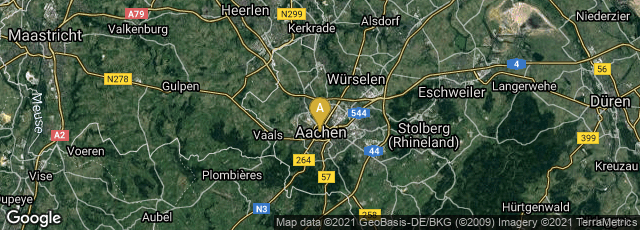

A: Mitte, Aachen, Nordrhein-Westfalen, Germany
The Vienna Coronation Gospels, also known as the Coronation Evangeliar, is the principle work among a small group of surviving manuscripts produced in the scriptorium of the Palace School at Aachen sometime between 794 and 800. It was used by the Emperor Charlemagne at his coronation on Christmas Day 800 when he placed three fingers of his right hand on the first page of the Gospel of Saint John and took his oath. Traditionally, it is considered the manuscript found in Charlemagne's tomb when it was opened in the year 1000 by Emperor Otto III.
"To this day we do not know exactly where Charlemagne’s grave lies. And so we do not know either where the legendary event which is so important for the manuscript actually took place in the year 1000. Otto III had the grave opened and discovered the codex on the knees of the emperor, who had been buried in a sitting position. He removed the book – and thereby laid the foundation for its ascent to become the central book and work of art in the Empire. During the coronations of the kings, which without exception took place in Aachen until 1531, according to tradition the book was opened at the first page of St. John’s Gospel, and the future king took his oath under the eyes of St. John the Evangelist on the words 'In the beginning was the Word' " (http://www.faksimile.de/werk/Coronation_Gospels_of_the__Holy_Roman_Empire.php?we_objectID=800, accessed 11-03-2013).
"The Coronation Evangeliar manuscript consists of 236 crimson-dyed parchment pages with gold and silver ink text. The pages measure 32.4 cm × 24.9 cm (12.8 in × 9.8 in), and contain text presented in one column, 26 lines per page. The incipit page of each Gospel shows the three writing styles common to valuable illustrated manuscripts from the late antique period—the capitalis rustica of the first line, followed by the monumental capitalis quadrata of the second line, which introduces the Latin text of the Gospel in gold ink, which is presented in continuous uncial script with no spaces between the words or punctuation.
"The book is decorated with 16 plates and four portraits depicting the Evangelists—one at the start of each Gospel. The portrait paintings are in a Carolingian style derived from Byzantine art. In the margin of the first page of the Gospel of Luke the Greek name Demetrius presbyter is written in gold capital letters. This may be the signature of the scribe or illuminator and may indicate that there were Byzantine artists in the court of Charlemagne.
"The Coronation Evangeliar cover was created by the goldsmith Hans von Reutlingen of Aachen c. 1500. Designed in high relief, the gold cover shows God the Father seated in front of the canopy of his throne. His left hand is closed over the Bible, and his right hand is raised in a gesture of blessing directed at Mary, who is shown grasping her heart during the Annunciation. The right side of the cover shows the Angel of the Annunciation. God the Father is dressed in imperial vestments and wearing a mitre crown, similar to the one worn by Maximilian I, who was Holy Roman Emperor at the time the cover was produced. The four corners of the front cover are decorated with four medalions bearing symbols of the four Evangelists" (Wikipedia article on Vienna Coronation Gospels, accessed 11-03-2013).
The Coronation Evangeliar is preserved as part of the Imperial Treasury (Schatzkammer) in the Hofburg Palace, affiliated with the Kunsthistorisches Museum in Vienna. (Schatzkammer, Inv. XIII 18).